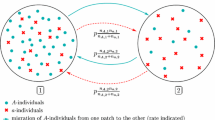Abstract.
Parapatric speciation is studied using an individual-based model with sexual reproduction. We combine the theory of mutation accumulation for biological ageing with an environmental selection pressure that varies according to the individuals geographical positions and phenotypic traits. Fluctuations and genetic diversity of large populations are crucial ingredients to model the features of evolutionary branching and are intrinsic properties of the model. Its implementation on a spatial lattice gives interesting insights into the population dynamics of speciation on a geographical landscape and the disruptive selection that leads to the divergence of phenotypes. Our results suggest that assortative mating is not an obligatory ingredient to obtain speciation in large populations at low gene flow.
Similar content being viewed by others
References
E. Mayr, Animal Species and Evolution (Harvard Univ. Press, 1963)
S. Gavrilets, Nature 403, 886 (2000)
R. Lande, Evolution 36, 213 (1982)
F. Turner, G.M. Burrows, Proc. R. Soc. Lond. B 260, 287 (1995)
G. van Doorn, A. Noewst, P. Hogeweg, Proc. R. Soc. Lond. B 265, 1915 (1998)
M. Higashi, G. Takimoto, N. Yamamura, Nature 402, 523 (1999)
A. Kondrashov, F. Kondrashov, Nature 400, 351 (1999)
U. Dieckmann, M. Doebeli, Nature 400, 354 (1999)
K. Luz-Burgoa, S. Moss de Oliveira, J.S. Sá Martins, D. Stauffer, A.O. Sousa, Braz. J. Phys. 33, 623 (2003)
M.E. Arnegard, A.S. Kondrashov, Evolution 58, 222 (2004)
C.R. Almeida, F.V. de Abreu, Evol. Ecol. Res. 5, 730 (2003)
A.H. Porter, N.A. Johnson, Evolution 56, 2103 (2002)
W.R. Rice, E.E. Hostert, Evolution 47, 1637 (1993)
U.K. Schliewen, D. Tautz, S. Pääbo, Nature 368, 629 (1994)
D. Schluter, Science 3266, 798 (1994)
S. Via, Trends Ecol. Evol. 16, 381 (2001)
J.S. Sá Martins, S. Moss de Oliveira, G.A. de Medeiros, Phys. Rev. E 64, 021906 (2001)
S. Gavrilets, Fitness landscapes and the origin of species (Princeton University Press, 2004)
J. Coyne, H. Orr, Speciation (Sinauer Associates, 2004)
M. Slatkin, Genetics 75, 733 (1973)
J.A. Endler, Science 179, 243 (1973)
M. Kirkpatrick, N.H. Barton, Am. Nat. 150, 1 (1997)
N. Sanderson, Evolution 43, 1223 (1989)
T. Day, Evolution 54, 715 (2000)
J.B.S. Haldane, J. Genet. 48, 277 (1948)
M. Caisse, J. Antonovics, Heredity 40, 371 (1978)
M. Doebeli, U. Dieckmann, Nature 421, 259 (2003)
J. Polechova, N.H. Barton, Evolution 59, 1194 (2005)
T.J.P. Penna, J. Stat. Phys. 78, 1629 (1995)
S. Moss de Oliveira, P.M.C. de Oliveira, D. Stauffer, Evolution, Money, War and Computers (Teubner, 1999)
D. Stauffer, P.M.C. de Oliveira, S. Moss de Oliveira, T.J.P. Penna, J.S. Sá Martins, An. Acad. Bras. Ci. 731, 15 (2001)
A.O. Sousa, Eur. Phys. J. B 39, 521 (2004)
S. Gavrilets, H. Li, M. Vose, Proc. R. Soc. Land. B 265, 1483 (1998)
P. Pamilo, M. Nei, W.H. Li, Genet. Res. 49, 135 (1987)
D. Makowiec, Physica A 289, 208 (2001)
N. Barton, G.M. Hewitt, Nature 341, 497 (1989)
M. Turelli, N.H. Barton, J.A. Coyne, Trends in Ecol. Evol. 16, 330 (2001)
R. Baxter, Exactly Solvable Models in Statistical Mechanics (Academic Press, 1982)
Author information
Authors and Affiliations
Corresponding author
Rights and permissions
About this article
Cite this article
Schwämmle, V., Sousa, A. & de Oliveira, S. Monte Carlo simulations of parapatric speciation. Eur. Phys. J. B 51, 563–570 (2006). https://doi.org/10.1140/epjb/e2006-00251-5
Received:
Published:
Issue Date:
DOI: https://doi.org/10.1140/epjb/e2006-00251-5




